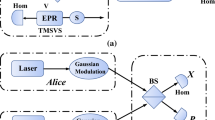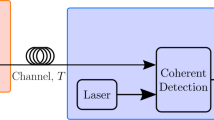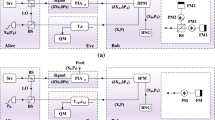Abstract
We introduce a new unidimensional CV-QKD protocol based on classical capacity achieving constellations and inspect how its cardinality translates into the secret key rate. The protocol requires simple modulation and detection procedures with intensity modulation on a single quadrature and homodyne detection. The secret key rate is computed for several constellation shapes, sizes and detection quantum efficiency for a pure loss quantum channel. We show that the capacity achieving constellations with increasing cardinality in a classical context preserve the same pattern in a QKD context by approximating the performance of Gaussian modulation. We also verify that the non-unit quantum efficiency detection effect is more severe on discrete modulation, diminishing the protocol performance and limiting its link range to no more than 100 km.






Similar content being viewed by others
Notes
We call attention the difference between \({\tilde{V}}_m\) and \(V_m\): the first refers to the modulation variance (or average energy), while the second corresponds to the quadrature operator \(\hat{q}\) variance.
Here, we assume the channel to be symmetric on its symplectic invariants, that is, the transmittance and excess noise are equal for both quadratures. The original paper presented a general case where the channel symmetry is initially discarded, forcing sporadic measurements on the non-modulated quadrature.
Here, we consider the operators relations in shot noise units, that is, \(\hat{q}= \hat{a}^{\dagger }+\hat{a}\) and \(\hat{p}= i(\hat{a}^{\dagger }- \hat{a})\), which is slightly different from the development found in [7] but causes no harm as its it will mainly differ on the normalization factor for the output current expected value. Check [12] for a good comparison between the canonical operators relations in different unit systems.
Note that it is a valid bosonic annihilation operator as it preserves the canonical commutation relation \([\hat{\varLambda },\hat{\varLambda }^\dagger ] = 1.\)
References
Assche, G.V., Cardinal, J., Cerf, N.J.: Reconciliation of a quantum-distributed Gaussian key. IEEE TIT 50(2), 394–400 (2004). https://doi.org/10.1109/tit.2003.822618
Bai, D., Huang, P., Zhu, Y., Ma, H., Xiao, T., Wang, T., Zeng, G.: Unidimensional continuous-variable measurement-device-independent quantum key distribution. Quantum Inf. Process. 19(2), 53 (2020). https://doi.org/10.1007/s11128-019-2546-5
Bai, Z., Yang, S., Li, Y.: High-efficiency reconciliation for continuous variable quantum key distribution. Jpn. J. Appl. Phys. 56(4), 44401 (2017). https://doi.org/10.7567/jjap.56.044401
Bloch, M., Thangaraj, A., McLaughlin, S., Merolla, J.M.: LDPC-based Gaussian key reconciliation. In: 2006 IEEE Information Theory Workshop, pp. 116–120. IEEE, Punta del Este, Uruguay (2006). https://doi.org/10.1109/ITW.2006.1633793
Brádler, K., Weedbrook, C.: Security proof of continuous-variable quantum key distribution using three coherent states. Phys. Rev. A 97(2), 1–16 (2018). https://doi.org/10.1103/PhysRevA.97.022310
Brassard, G., Salvail, L.: Secret-key reconciliation by public discussion. In: EUROCRYPT, pp. 410–423. Springer, Berlin (1994). https://doi.org/10.1007/3-540-48285-735
Cerf, N.J., Leuchs, G., Polzik, E.S.: Quantum information with continuous variables of atoms and light. Icp (2007). https://doi.org/10.1142/P489
Sun, F.-W., van Tilborg, H.: Approaching capacity by equiprobable signaling on the Gaussian channel. IEEE Tran. Inf. Theory 39(5), 1714–1716 (1993). https://doi.org/10.1109/18.259663
Ghorai, S., Grangier, P., Diamanti, E., Leverrier, A.: Asymptotic security of continuous-variable quantum key distribution with a discrete modulation. Phys. Rev. X 9(2), 021059 (2019). https://doi.org/10.1103/PhysRevX.9.021059
Grosshans, F., Grangier, P.: Continuous variable quantum cryptography using coherent states. Phys. Rev. Lett. 88(5), 57902 (2002). https://doi.org/10.1103/PhysRevLett.88.057902
Jouguet, P., Elkouss, D., Kunz-Jacques, S.: High-bit-rate continuous-variable quantum key distribution. Phys. Rev. A 90(4), 42329 (2014)
Laudenbach, F., Pacher, C., Fung, C.H.F., Poppe, A., Peev, M., Schrenk, B., Hentschel, M., Walther, P., Hübel, H.: Continuous-variable quantum key distribution with Gaussian modulation-the theory of practical implementations. Adv. Quantum Technol. 1(1), 1800011 (2018). https://doi.org/10.1002/qute.201800011
Leonhardt, U.: Measuring the Quantum State of Light No. 22 in Cambridge Studies in Modern Optics. Cambridge University Press, New York (1997)
Leverrier, A., Grangier, P.: Unconditional security proof of long-distance continuous-variable quantum key distribution with discrete modulation. Phys. Rev. Lett. (2009). https://doi.org/10.1103/PhysRevLett.102.180504
Liao, Q., Guo, Y., Xie, C., Huang, D., Huang, P., Zeng, G.: Composable security of unidimensional continuous-variable quantum key distribution. Quantum Inf. Process. 17(5), 113 (2018). https://doi.org/10.1007/s11128-018-1881-2
Marie, A., Alléaume, R.: Self-coherent phase reference sharing for continuous-variable quantum key distribution. Phys. Rev. A 95(1), 12316 (2017). https://doi.org/10.1103/PhysRevA.95.012316
Nguyen, K.C., Van Assche, G., Cerf, N.J.: Side-information coding with turbo codes and its application to quantum key distribution. In: International Symposium on Information Theory and Its Applications. Parma, Italy (2004)
Papanastasiou, P., Lupo, C., Weedbrook, C., Pirandola, S.: Quantum key distribution with phase-encoded coherent states: asymptotic security analysis in thermal-loss channels. Phys. Rev. A 98(1), 012340 (2018). https://doi.org/10.1103/PhysRevA.98.012340
Pilori, D.: Advanced Digital Signal Processing Techniques for High-Speed Optical Communications Links. Ph.D. Thesis, Politecnico di Torino (2019)
Qu, Z., Djordjevic, I.B., Anderson, J.: Two-dimensional constellation shaping in fiber-optic communications. Appl. Sci. 9(9), 1889 (2019). https://doi.org/10.3390/app9091889
Ralph, T.C.: Continuous variable quantum cryptography. Phys. Rev. A (1999). https://doi.org/10.1103/physreva.61.010303
Shannon, C.E.: A mathematical theory of communication. Bell Syst. Tech. J. (1948). https://doi.org/10.1002/j.1538-7305.1948.tb00917.x
Ungerboeck, G.: Channel coding with multilevel/phase signals. IEEE Trans. Inf. Theory 28(1), 55–67 (1982). https://doi.org/10.1109/TIT.1982.1056454
Usenko, V.C., Grosshans, F.: Unidimensional continuous-variable quantum key distribution. Phys. Rev. A 92(6), 062337 (2015). https://doi.org/10.1103/PhysRevA.92.062337
Wang, P., Wang, X., Li, J., Li, Y.: Finite-size analysis of unidimensional continuous-variable quantum key distribution under realistic conditions. Opt. Express 25(23), 27995 (2017). https://doi.org/10.1364/OE.25.027995
Wolf, M.M., Giedke, G., Cirac, J.I.: Extremality of Gaussian quantum states. Phys. Rev. Lett. 96(8), 080502 (2006). https://doi.org/10.1103/PhysRevLett.96.080502
Wu, Y., Verdú, S.: The impact of constellation cardinality on Gaussian channel capacity. In: 2010 48th Annual Allerton Conference on Communication, Control, and Computing, Allerton 2010, pp. 620–628 (2010). https://doi.org/10.1109/ALLERTON.2010.5706965
Yin, H.L., Zhu, W., Fu, Y.: Phase self-aligned continuous-variable measurement-device-independent quantum key distribution. Sci. Rep. 9(1), 49 (2019). https://doi.org/10.1038/s41598-018-36366-4
Zhao, W., Guo, Y., Zhang, L., Huang, D.: Phase noise estimation using Bayesian inference for continuous-variable quantum key distribution. Opt. Express 27(3), 1838 (2019). https://doi.org/10.1364/OE.27.001838
Zhao, W., Shi, R., Feng, Y., Huang, D.: Unidimensional continuous-variable quantum key distribution with discrete modulation. Phys. Lett. A 384(2), 126061 (2020). https://doi.org/10.1016/j.physleta.2019.126061
Zhao, Y.B., Heid, M., Rigas, J., Lütkenhaus, N.: Asymptotic security of binary modulated continuous-variable quantum key distribution under collective attacks. Phys. Rev. A 79(1), 1–14 (2009). https://doi.org/10.1103/PhysRevA.79.012307
Acknowledgements
This work was performed in the Institute for Studies in Quantum Information and Computation (iQuanta) at the Federal University of Campina Grande (UFCG), Paraíba, Brazil, and supported in part by the National Council for Scientific and Technological Development (CNPq) under research Grant No. 305918/2019-2 and the Coordination of Superior Level Staff Improvement (CAPES/PROEX).
Author information
Authors and Affiliations
Corresponding author
Ethics declarations
Conflict of interest
The authors declare that they have no con ict of interest.
Additional information
Publisher's Note
Springer Nature remains neutral with regard to jurisdictional claims in published maps and institutional affiliations.
Rights and permissions
About this article
Cite this article
Dias, M.A., de Assis, F.M. The impact of constellation cardinality on discrete unidimensional CVQKD protocols. Quantum Inf Process 20, 284 (2021). https://doi.org/10.1007/s11128-021-03222-w
Received:
Accepted:
Published:
DOI: https://doi.org/10.1007/s11128-021-03222-w




